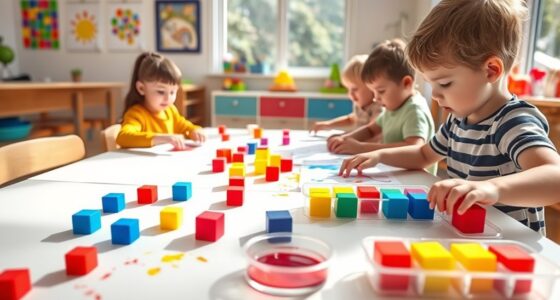Loose parts play setups spark imagination by using simple objects like stones, fabric scraps, and recycled materials that invite open-ended exploration. You can create versatile environments where children lead their play, transforming items into spaceships, castles, or whatever they imagine. These setups promote creativity, problem-solving, and emotional growth while being adaptable to any space. Keep exploring ways to spark their curiosity, and you’ll discover even more exciting ideas to inspire limitless play.
Key Takeaways
- Use varied, everyday objects like sticks, stones, and fabric scraps to inspire open-ended play and creativity.
- Arrange loose parts in accessible, flexible setups that children can easily manipulate and transform.
- Incorporate natural and recycled materials to encourage exploration and storytelling in any environment.
- Create inviting spaces that promote child-led discovery, imagination, and problem-solving with simple items.
- Rotate and add new loose parts regularly to maintain curiosity and ongoing creative possibilities.

Have you ever wondered how children’s imaginations flourish during play? It’s often the simple, everyday objects that *unleash* their creativity and encourage open-ended exploration. When kids are given access to a variety of creative materials, they discover endless possibilities for storytelling, building, and transforming their environment. These loose parts—like sticks, stones, fabric scraps, or recycled items—aren’t fixed or limited in purpose. Instead, they serve as versatile tools that invite children to experiment, invent, and problem-solve. By integrating such loose parts into play setups, you create a space where children can explore ideas freely, without predetermined outcomes.
Simple objects like sticks and stones unlock children’s creativity and open-ended exploration.
In these setups, the focus shifts from structured activities to allowing children to lead the way. They might turn a collection of buttons into a spaceship or stack blocks into towering structures, revealing their unique perspectives and problem-solving skills. This kind of open-ended exploration isn’t about right or wrong answers; it’s about nurturing curiosity and fostering a sense of agency. As children manipulate and combine different loose parts, they develop fine motor skills, spatial awareness, and critical thinking. They learn to adapt and innovate as they discover new ways to use the materials, which keeps their minds engaged and sparks their imagination.
In addition, engaging in creative play supports cognitive development and emotional resilience by allowing children to process their experiences through imaginative scenarios. Using creative materials that are easily accessible and varied encourages children to think outside the box. When they have a range of options, they can make connections between objects, invent stories, or design their own games. This freedom to experiment is *crucial* for developing confidence and independence. It’s also an excellent way to support social skills, as children collaborate, share ideas, and negotiate roles during their open-ended exploration. The beauty of loose parts play is that it’s adaptable to any environment—whether outdoors in nature or indoors in a classroom or home setting. All you need are simple materials that can be moved, combined, and transformed.
Ultimately, by providing a variety of creative materials for open-ended exploration, you’re giving children the tools to build their worlds from their imagination. This type of play nurtures their innate desire to explore and create, helping them develop essential skills while having fun. It’s a reminder that sometimes, the simplest items can *open* the most extraordinary ideas. When children are empowered to lead their play, their imaginations thrive, and they gain a lifelong love for discovery and learning.
Frequently Asked Questions
How Can I Encourage Shy Children to Participate?
To encourage shy children to participate, start with trust-building activities that create a safe space. Use gentle encouragement, praising small efforts to boost their confidence. Offer opportunities for one-on-one or small group play, allowing them to feel comfortable. Incorporate loose parts play setups that invite exploration without pressure, helping shy children gradually engage at their own pace. Patience and understanding are key to helping them feel secure and willing to join in.
Are There Safety Concerns With Loose Parts?
Like a knight preparing for battle, you need to assess risks before loose parts play. Safety concerns are real, but following safety guidelines and conducting thorough risk assessments help you create a safe environment. Guarantee parts are non-toxic, free of sharp edges, and appropriate for children’s ages. Regularly inspect items for wear and tear. With these precautions, you can confidently encourage exploration while keeping children safe and engaged.
What Are the Best Materials for Outdoor Setups?
You should choose natural materials like wood, stones, and shells, as they’re durable and safe for outdoor play. Recycled objects such as metal cans, plastic bottles, and cardboard pieces also work well, encouraging creativity while supporting sustainability. Make sure all materials are clean, free of sharp edges, and weather-resistant. This way, you create inviting setups that spark imagination and keep children safe during outdoor play.
How Do I Manage Mess During Free Play?
Ever wonder how to keep the mess manageable during free play? You can set up simple storage solutions like bins or baskets for easy cleanup, and establish clear cleanup routines. When kids know where to put materials and how to tidy up, play stays fun and organized. Encourage them to take responsibility, making cleanup part of the play experience itself. This way, mess becomes manageable and play remains joyful.
Can Loose Parts Play Support Special Needs Children?
Yes, loose parts play can support children with special needs by enhancing sensory integration and social skill building. You can create open-ended setups that allow children to explore textures, shapes, and sounds, helping them process sensory input comfortably. Additionally, loose parts encourage cooperation and communication, fostering social interactions. By offering adaptable, inviting environments, you empower children to express themselves and develop essential skills at their own pace.
Conclusion
Research shows that children engaged in loose parts play develop stronger problem-solving skills and creativity. By providing open-ended materials, you foster an environment where imagination thrives. Remember, in a recent study, 85% of children reported feeling more confident and independent after participating in such play. So, keep encouraging these setups—you’re helping children build essential skills for their future while having fun. Embrace the chaos and watch their imaginations soar!









